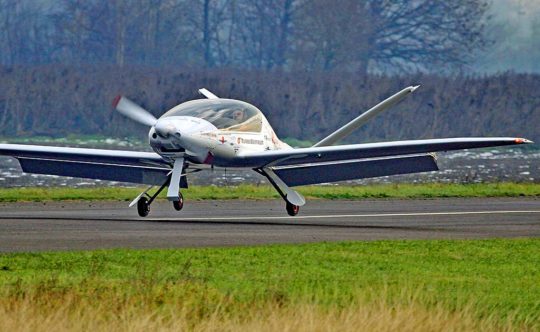
Blackwing edged out Risen with its record flight, prompting a representative of Porto Aviation Group to provide a deeper perspective. Many years ago as an active hang glider pilot, I found the records-keeping body, FAI, to be very strict and formal in how it administered world record claims.
Siren or Risen
Whatever the Name; It’s Fast
One of my most popular videos (with well over a half million views and hundreds of comments) is an interview I did with Alberto Porto, developer of Risen. It was 2015 and he had just introduced his speedster He said it would set records and it turns out he knew what he was saying.
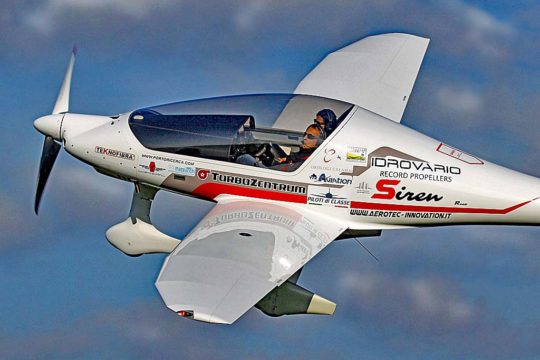
Porto’s Siren looks fast even with fixed landing gear.
When I read Blackwing’s statements about eclipsing an older record, I wondered at the name Siren, the previous record holder. I wondered if it was a misspelling of Risen, but no, it was not. Risen is the retractable gear model. Siren is a fixed wing example (nearby photos).
Porto commercial director Stéphan D’haene wrote, “The [Blackwing people] were flying at FL100 (10,000 feet MSL). We were flying sea level. That makes a huge difference,” he exclaimed!
“We are in discussion with FAI for clarification of the rules,” Stéphan continued, “as different countries make different interpretations, apparently.” He refers to FAI’s practice of designating a national group to oversee and verify record claims before sending to the international headquarters.
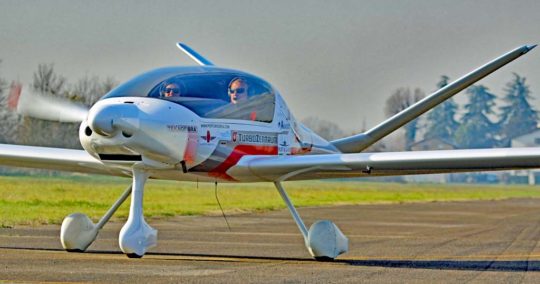
Porto Aviation Siren fixed gear with a carbureted Rotax 912 ULS heading out for a 50km closed course record.
I noted the inexact match of record attempts. SEA/Porto’s record attempts were flown at a low altitude under FAI rules that “have evidently been reinterpreted,” Stéphan speculated. Any flexibility in how FAI reads the data is hard for me to accept given how rigid they used to be. In addition, he noted Siren was limited to 1,042 pounds (472.5 kilograms, a European microlight standard). Stall was less than 35 knots and Porto’s fixed gear design had some 40% less horsepower available. Those points add up to a significant difference.
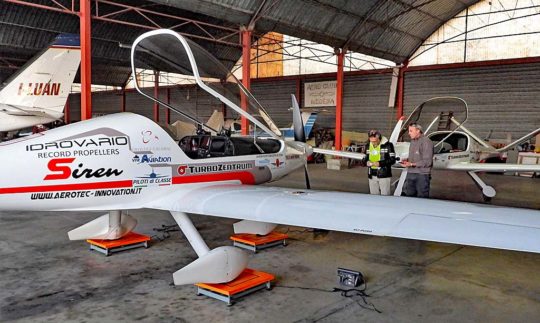
Siren undergoes a weighing process under FAI supervision; fuel and crew must remain below 472.5 kilograms (1,042 pounds). Although Siren is labeled “Turbozentrum,” the aircraft is equipped with a non-turbocharged 912 ULS and is completely stock. Turbozentrum was one of the record attempt sponsors.
“For the Risen 914T — introduced in 2016 — our brochure stated 75% cruise at 355 kilometers per hour (192 knots),” Stéphan noted. “At full power the aircraft will exceed 200 knots at FL100.”
“Altitude is a key contributing factor to a record based on ground speed,” observed Porto Aircraft, expressing a point most pilots will recognize. “We all know, that speed varies with altitude.”
Stéphan said, “[This means] the two record flights (Blackwing more recently and Risen a few years back) were not done in comparable conditions. For that reason, they should not be compared.” He explained that FAI previously stuck to a consistent approach that allowed records to be compared using a correction factor.
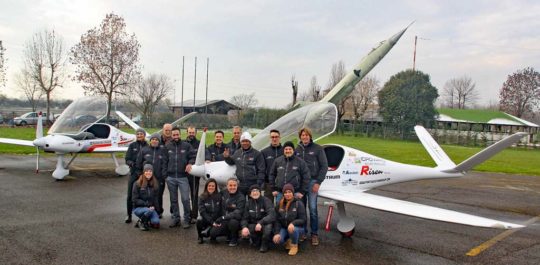
Team Porto Aviation Group pose with both record-setting aircraft (fixed-gear Siren at back with retractable Risen behind team).
Speaking for company boss Alberto Porto, Stéphan believes Risen 914 Turbo would fly 10 kilometers per hour (5.4 knots) faster than the Blackwing powered by the more powerful 915iS. He also reported, “Alberto did not go all the way during that run. He left some room to do future records.”
“It’s very simple. If we extrapolate the performance of the Risen 914T using the FAI correction factor, Risen 914T would be 392 kilometers per hour and [thereby] faster than Blackwing,” Stéphan stated. “We didn’t even mention the 22.5% more power” that Blackwing’s 915 has over Risen’s 914. In the previous benchmark, the retractable, turbocharged Risen claimed a straight-line record — but the story continues.
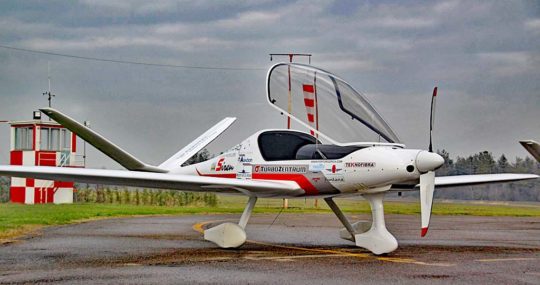
“We [did not believe another company would attempt to break a] record set by our fixed-gear Siren model,” expressed Stéphan. “Why? Because [any speed] increase would be marginal, not much to brag about. All manufacturers in Europe understood that very well. There was [little] to win in beating this record and [until recently] everybody steered clear of the 50 kilometer closed circuit.”
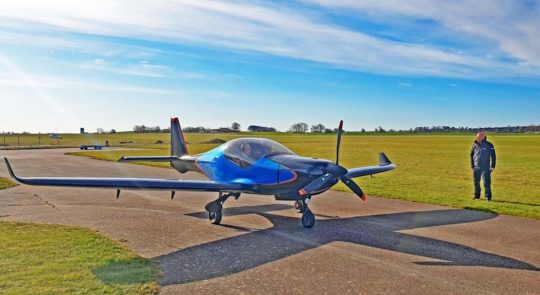
Previously reported Blackwing heads out for a record attempt.
“Not so for the Swedish,” Stéphan believed. “…they found a solution but facts are still facts.” The Blackwing 915 performance on the 50 kilometer course corrected to normal FAI calculation is 302 kilometers per our versus 288 for the fixed-gear Siren. That’s 14 kilometers per hour (7.6 knots) faster for a retractable gear design with 41% more power and higher cost. Just imagine a fixed-gear Siren with that same Rotax 915iS?”
Closing Thoughts
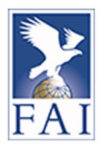
I suspect it is still not over but here we have an example of how records work to stimulate new innovation. While the exchange of official FAI record bragging rights from Blackwing and Porto make for interesting reading, the truth is both have accomplished a lot — speeds beyond 200 miles an hour on fairly small engines. Such a figure speaks to airframe efficiency, clever engineering, and determination. Aviation can use all of that it can get. Bravo to both companies!


I would love to see the Siren equipped with fixed-gear. I’m willing to give up a small amount of airspeed in exchange for lower insurance premiums and maintenance costs, not to mention a possibly lower purchase-price.
Did they mention what altitude they were when they recorded the Siren at 155 kts (288 kph)? At higher altitudes, there’d likely be less difference between the fixed & retractable gear due to reduced drag.
I am sure the manufacturer can answer your question, please use links in the article to inquire.
The Risen is again the fastest ultralight of the world. The 16th of April [2021] a Risen 914 set the new speed record beating the Blackwing 915iS with 379 kilometers per hour (236 mph!) on the 50-kilometer closed course and 400 kilometers per hour on the 15-kilometer course. Now let’s wait for the 915iS.
I agree that there is room for a fast small aircraft, but we should stop with calling his a “Light Sport.” This fits into Experimental or perhaps they can make it for Part 23. For sure no Sport Pilot will be able to fly it based on performance, speed, retractable gear…and so on. I fear many have lost the plot on what this class was supposed to be about and who it was for. I guess that the market is in the small light performance aircraft and that’s fine but call it what it is…
The U.S. LSA Siren model claims to have like 150 knots sea level but LSA regs limit it to 120 knots. How does Siren do that? Is it like Bristell where it can go faster but a notice not to exceed a certain RPM at sea level is put inside? Can we expect the actual LSA certified aircraft to cruise at 150+ knots at altitude?
First, Siren is not presently a Light-Sport Aircraft. I have not seen proof but it must have an Experimental airworthiness certificate. This impressive aircraft has not declared compliance to ASTM so it has not been accepted by FAA as a SLSA. This means it has no speed limit but if it can achieve indicated speeds above 120 knots it cannot be operated by someone with a Sport Pilot certificate or exercises those privileges (meaning, no medical).
As to speed, the 120-knot limit is indicated. True air speed at altitude can be higher than 120 knots and that’s how Bristell can promote their speed (they also advertise in miles per hour, so please read carefully).
If I recall correctly, Stephan used to be the sales manager for Blackwing, so this adds a bit more intrigue. Aviation can use more if this, I agree
Hello Kai: I did not hear this earlier, but you are correct as Niklas of Blackwing also confirmed. Perhaps I should have remembered as I got email from Stéphan when he was with Blackwing in 2017. Given a usually overflowing inbox, I failed to recall that.
While Niklas has raised this point as well, it is worthwhile for readers to note the man who recently raised questions about Blackwing’s record attempt was formerly with that Swedish company. Ah, the intrigue of our industry…
In my opinion, the US market has fallen behind.The incredible innovation in Europe with their Ultralight or Microlight category makes our LSA look horrible.
Note a couple of major differences with our LSA and Europe’s UL and their 600 kilogram weight (1320 pounds). They can have simple raised gear and no speed limit. The Porto Risen (raised gear) is incredibly stable at any speed. The flaps on that plane are enormous. The cabin is 48.4 inches in width (1.23 meters) and has the lowest drag of any Ultralight and, I would guess, LSA aircraft. With low drag comes more speed and safety as it cuts through the air cleaner. A pilot can fly as slow as they wish but in a more stable flying airplane. This isn’t all about speed. Low drag translates into comfort and stability.
In my opinion, let the race go on! These are exceptional aircraft. No one needs to hang their head. I just wish they would produce a four-seat model. These two seat planes are too confining for me!
So here we are many years after the FAA started LSA as a class of aircraft. Sadly, at least to me, many have lost the whole concept of light, affordable and easy to fly aircraft. We are now moving into a new phase of LSA where no 25 hour sport pilot can ever operate. Seriously, pushing 200 miles per hour? People are nuts. So much for the concept of easy to fly. Don’t get me wrong; I love innovation and sexy designs, however, this slick and fast stuff was never what the class was about.
The Bristell 915iS Turbo has the same gross weight as the 100 horsepower Rotax ULS and the same 39-knot stall speed and the same 60-knot approach speed and the same 45-knot touch down speed.
Still an easy to fly aircraft made especially for tall and heavy Americans. Pilots 6’10” and 280 pounds fit comfortably to the Bristell 51-inch-wide cabin.
Dan: I always appreciate your attempt to be fair and positive. Think any of them want to build a SUV-sized Maserati? I will trade comfort for speed on a multi-hour trip.